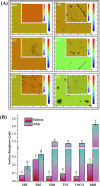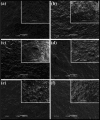In Vitro Hydrolytic Degradation of Giomer-Based and Fluoride-Releasing Bulk Fill Composites Simulated for Patients with Gastroesophageal Reflux Disease
- PMID: 40488085
- PMCID: PMC12138672
- DOI: 10.1021/acsomega.5c00784
In Vitro Hydrolytic Degradation of Giomer-Based and Fluoride-Releasing Bulk Fill Composites Simulated for Patients with Gastroesophageal Reflux Disease
Abstract
Gastroesophageal reflux disease (GERD) often leads to tooth demineralization and degradation of dental restorations, increasing surface roughness and reducing strength. Limited studies have addressed acidic pH effects on fluoride-releasing giomer composites. This in vitro study evaluates surface roughness and flexural strength (FS) of six bulk-fill compositesSTARK, Filtek One Bulk Fill Restorative (FBF), SureFil SDR Flow (SDR), Tetric N-Ceram (TNC), X-tra fil VOCO, and Beautifil-Bulk restorative (BBR)before and after acidic exposure and abrasion caused by brushing cycles. Specimens tested included 60 disks (2 mm thick, 8 mm diameter) for surface roughness and 60 bar (25 mm × 2 mm × 2 mm) for FS. Samples were immersed in hydrochloric acid (pH 1.2) at 37 °C for 24 h, followed by 5000 brushing cycles (100 cycles/min) using medium-bristle toothbrushes. Surface roughness (Ra) and FS were measured at the baseline and post-treatment. Statistical analysis was performed by conducting Shapiro-Wilk tests, one-way ANOVA, and Tukey posthoc tests (α = 0.05). Results showed that BBR exhibited the highest increase in surface roughness after acidic exposure and brushing, followed by SDR, TNC, and VOCO. FBF and STARK demonstrated minimal changes. FS reduction was most significant in BBR (86.11 to 69.79 MPa, 18.95%) and SDR (106.78 to 88.27 MPa, 17.14%). These findings suggest that giomer-based fluoride-releasing composites, such as BBR and SDR, are susceptible to acidic degradation and brushing wear.
© 2025 The Authors. Published by American Chemical Society.
Figures



Similar articles
-
Roughness profile and surface roughness after toothbrushing and degree of conversion of bulk-fill resins.Braz Oral Res. 2024 Dec 20;38:e128. doi: 10.1590/1807-3107bor-2024.vol38.0128. eCollection 2024. Braz Oral Res. 2024. PMID: 39775417
-
In Vitro Evaluation of Surface Properties and Wear Resistance of Conventional and Bulk-fill Resin-based Composites After Brushing With a Dentifrice.Oper Dent. 2019 Nov/Dec;44(6):637-647. doi: 10.2341/18-200-L. Epub 2019 Jan 31. Oper Dent. 2019. PMID: 30702404
-
Effect of Acidic Beverages on the Hardness, Elastic Modulus and Wear Resistance of Giomer and Nongiomer Bulk-fill Materials.Oper Dent. 2023 Jul 1;48(4):435-446. doi: 10.2341/22-063-L. Oper Dent. 2023. PMID: 37352458
-
Effect of tooth brushing on gloss retention and surface roughness of five bulk-fill resin composites.J Esthet Restor Dent. 2018 Jan;30(1):59-69. doi: 10.1111/jerd.12350. Epub 2017 Dec 5. J Esthet Restor Dent. 2018. PMID: 29205770
-
Multiple-peak and single-peak dental curing lights comparison on the wear resistance of bulk-fill composites.Braz Oral Res. 2018 Dec 17;32:e122. doi: 10.1590/1807-3107bor-2018.vol32.0122. Braz Oral Res. 2018. PMID: 30569972
References
LinkOut - more resources
Full Text Sources
Miscellaneous
